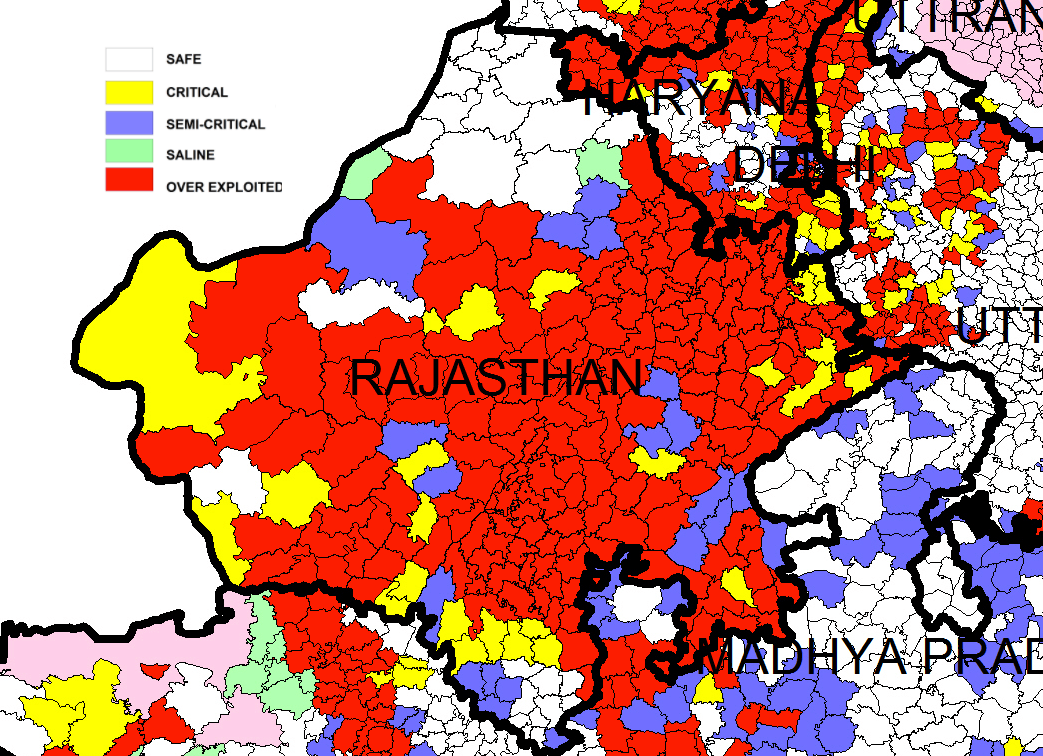Rajasthan faces one the greatest scarcity of water resources in the country. It has 13.88% of India’s cultivable area, 5.67% of population and about 11% of country’s livestock but it has only 1.16 % of surface water and 1.70% of ground water. Thus, Rajasthan a state with about 10% of land area has only around 1% of country’s water resources.
Water Resources of Rajasthan:
The State’s water resources are categorised in following terms:
1. Surface Water (SW):
1.1 Surface water (stream flows) generated from within Rajasthan boundaries:
- The surface water potential of the state from internal sources comprising 14 Rainfed river basins is estimated at 15.86 million acre feet.

- Surface Water Sources: Rivers, Lakes & Dams of Rajasthan.
1.2 Imported Surface Water:
- Imported water delivered to Rajasthan from other states by means of several projects under relevant inter-state agreements.
The share of Rajasthan in out of State rivers as per various inter-State agreements
| S.No | Resource | Allotted Water in MAF (Million Acre Feet) |
| 1 | Gang Canal | 1.11 |
| 2 | Bhakra Canal | 1.41 |
| 3 | Narmada | 0.5 |
| 4 | Ravi-Beas | 8.6 |
| 5 | Yamuna Water | 0.91 |
| 6 | Mahi Water | 0.37 |
| 7 | Chambal/Kota Barrage | 1.6 |
| Total | 14.5 |
2. Ground Water (GW):
- Groundwater availability in Rajasthan is highly variable, depending on hydrological conditions.
- The limited ground water resources in Rajasthan are increasingly being exploited for irrigation, Industrial and domestic uses.
- In 2011, out of 243 Blocks. the ground-water status was as follows:
| Parameter | No. of Blocks |
|---|---|
| 1. Over Exploited (greater than 100%) | 172 |
| 2. Critical (90% – 100%) | 25 |
| 3. Semi- critical (70%-90%) | 20 |
| 4. Safe (Less than 70%) | 24 |
| 5. Saline Water Blocks | 2 |
| Total | 243 |

Major Issues related to Water in Rajasthan:
Scarcity of surface and groundwater
Rajasthan is the driest state with nearly 70 percent (2/3rd) of the area classified as arid and semi arid region. The annual average demand in 2010 in the state was of 31333.74 million cubic meter (MCM) with an availability of 10448.59 MCM annual average surface water (having 75% dependability) and 10563.01 MCM of annual average ground water. Hence there is gap of around 30% in demand and availability.
Water use priority:
According to the document State Water Policy (SWP), February 2010, State Water Resources Planning Department, Rajasthan, Jaipur, water allocation priorities for water resources management and planning purposes, are as follows:
- Human Drinking Water
- Livestock drinking
- Water other domestic,
- Commercial and municipal water uses
- Agriculture
- Power generation Environmental and ecological
- Industrial
- Non-consumptive uses, such as cultural, leisure and tourist uses
- Others
The above water allocation priorities were followed while carrying out water supply and demand balance block-wise and micro watershed wise.
Ground-Water Quality Issues:
Rajasthan is over-dependent on groundwater. The major problems associated with groundwater quality are fluoride, nitrate, and salinity. The worst affected districts with 50 percent or more concentrations are:
Fluoride:
- Tonk, Jaipur, Nagaur, Ajmer, Bhilwara, Sirohi, Bundi and Pali
- Causes of High Flouride:
- Presence of rocks like Pegmatite , Gabbros etc. containing minerals like Fluorspar, Fluorite, Lepidolite, Tremolite.
- Presence of calcite and dolomite which accelerate the leaching of fluoride to the groundwater.
- The arid climate with high evaporation and insignificant natural recharge increase fluoride concentration in the groundwater.
Nitrate > 100 ppm:
- Churu, Nagaur, Jhunjhunu
Total Dissolved Solids (TDS) > 2000 ppm:
- Churu, Barmer, Bharatpur
Iron > 1ppm:
- Bhilwara, Jodhpur, Baran, Jaipur
Surface Water Quality Issues:
- The two major causes of surface water pollution are sewage water and industrial effluent.
- Rajasthan has clusters of textile printing units emitting wastewater containing dyes leading to heavy metal pollution of surface and groundwater.
- Industrial water pollution in the state is mainly con ned to Kota, Alwar, Udaipur, Jodhpur, Pali, Balotra, Sanganer, Bhilwara, Jhotwara, and Bagru areas.
Steps taken to Improve Water Resources of Rajasthan
Water Vision 2045
Water Resource Vision 2045 has been prepared to highlight the short term (upto 2015) and long term (upto-2045) thrust areas and action plan which are pre-requisites for successful implementation of the State Water Policy and Plan and achieving the objective of optimum use of every drop of scarce and precious utilisable water resource.
Government Organisations
- Water Resources Department
- Rajasthan River Basin & Water Resources Planning Authority
- Command Area Development & Water Utilization Department
- Rajasthan River Basin & Water Resources Planning Authority
- Ground Water Department
- Watershed Development and Soil Conservation Department
- Rural Development & Panchayati Raj Department
- Public Health Engineering Department (PHED)
Schemes to improve water availability
- Mukhya Mantri Jal Swavlamban Abhiyan
- Interlinking of Rivers
- Rooftop Rain Water Harvesting
- Roof Top RWH has been made mandatory in State owned buildings of plot size more than 300 Sq.m with effect from 03.01.2006.
- Under the Mahatma Gandhi National Rural Employment Guarantee Act (MNREGA) the activities related to water conservation and rain-water harvesting, drought proofing, construction of irrigation canals, rejuvenation of traditional water bodies and developing drainage in the waterlogged areas are being taken up.
- Construction of Dams & Reservoirs.
- Watershed development:
- There are various programs in the state under which watershed development is done are: The Drought Prone Area Program, Desert Development Program, Integrated Wasteland Development Program (Plain), National Watershed Development Program for Rain-fed Areas, Pushkar Gap Project, Peoples Action For Watershed Development Initiatives, Combating Desertification Project and Integrated Wasteland Development Program.
Read Further:
- Rajasthan State Water Policy, 2010 PDF: English | Hindi
- National Water Policy, 2002 PDF: English
- Central Ground Water Board – Rajasthan Profile: PDF

